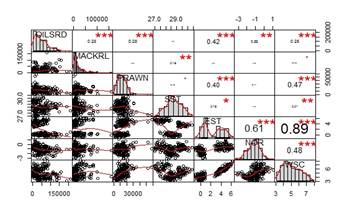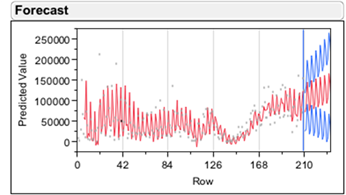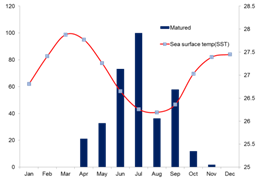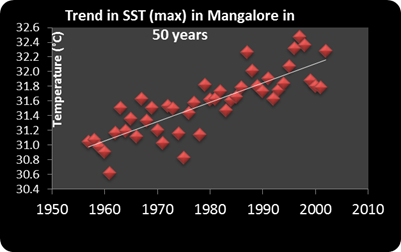|
|
|
Capture fisheries research on selected species along the Indian coast
 |
Correlation analysis of Marine species with Environmental variables studied
Correlation analysis of environmental variables with oil sardine, mackeral and prawn revealed that there is a significant correlation between oilsardine and prawn with westerly winds and mackeral with SST |
Seasonal ARIMA model was attempted for Catch forecasting for Oil Sardine along SouthWest coast
Seasonal ARIMA model for catch forecasting for Oil Sardine along SW coast showed that predicted annual catch in 2018 will stagnate at around 6,80,000 t. Additional landings to be utilised productively through value chain approach. |

|
Biology & Trophodynamics
Impact of climate change on capture fisheries
-
Comparison of spawning activity of threadfin breams was done between Chennai and Mangalore to assess longitudinal variations along similar latitudinal planes.
-
A marked difference in length at first maturity, asymptotic length and fecundity along the two coasts was noticed.
-
Real time data showed that spawning season of oil sardine showed significant negative correlation with SST. These databases collected along the coast could be used for developing scenarios for 2030 and 2050 for studying the effect of temperature on spawning of fishes.
-
Along the south west coast, published literature shows spawning season of Nemipterus randalli to be October – March; now a change in the spawning period to August – November.
|
 |
-
Off Kochi, threadfin breams showed very strong relation to bottom water temperature; the preferred temperature was seen to be 23.80C ; highest catch of the decade was 6453 tonnes when the bottom water temp was 22.8 0C.
|
 |
Along the Kerala coast, the mean length of Nemipterus japonicus was 179 mm when the SST was 28.720C; the mean length then decreased slowly to 132 mm in 2011 when SST increased to 28.840C.
-
Relation between rainy days and spawning of Nemipterus japonicus along SE coast was attempted: A positive correlation was noted between spawning activity of Nemipterus japonicus with rainy days. Spawning activity has increased during NE monsoon when the no. of rainy days is increasing as well as the temperature is low.
-
Spawning season of Indian Mackerel has shown a shift from March - July in 1957 to January - April during 2011-14 along the south- west coast of India.
-
Mackerels matured earlier 18.38 cm in 2012 compared to 22.4 cm in 1958 on the West coast of India. Length at first maturity (Lm) shows a strong negative correlation (-0.61) with temperature which indicates the spawning is taking place early in the life cycle.
-
Diet studies during 1960-61 reported the dominance of zooplankton, copepods, whereas present observation showed a dominance of phytoplankton consisting of Coscinodiscus sp. consistently during 2011-14, indicating that the diet of mackerel has changed over a period of 40 years.
-
Off Veraval coast, positive impact of SST was seen on Katsuwonus pelamis, Auxis thazard and Scomberomorus guttatus, whereas a negative impact of SST on yellowfin tuna and bill fishes was noticed. A significant negative correlation of (r2-0.618) (p value<0.01), was observed between maturity of ribbonfish and SST; ribbon fish forms the prime fishery resource off Gujarat Coast.
-
Coastal shrimps were found to mature earlier at Mangalore (last 30 years). Fecundity loss was estimated per individual at size at maturity during 30 years
-
28 % loss per individual of M.dobsoni was recorded in the number of eggs.
-
41 % loss per individual of M.monoceros was recorded in the number of eggs.
-
6 % loss per individual of P. stylifera was recorded in the number of eggs.
-
This shows that of P. stylifera has more tolerance to climate change.
|
 |
Size based vulnerability to ocean acidification was noticed: Assessment of variation in zooplankton community with pH showed change in community structure. Macro-zooplankton dominated the community. Calciphorous zooplankton (bivalve larvae, pteropods and phyllosoma) and micro-zooplankton were found to be negatively impacted.
With increase in SST, evidences are now available for :
- Increase in dispersal and abundance of small pelagics (oil sardine and mackerel).
- Reduction in mean size in the fishery (mackerel, Nemipterus)
- Reduction in length at first maturity (mackerel, coastal prawns).
- Reduction in fecundity (coastal prawns).
- Change in spawning season (Nemipterus)
- Change in diet composition (oil sardine)..
|
Vulnerability Assessment
- Coastal Vulnerability Indices of Tuticorin, Nagapattinam, Ramanathapuram and Cuddalore districts of Tamil Nadu and Krishna district of Andhra Pradesh were constructed using Patnaik and Narayan Model
- The highly vulnerable villages in Ramanathapuram district were Mandapam (0.59), Rameswaram (0.401), Valinokkam (0.276), Natarajapuram (Dhanuskodi) (0.269), Pamban (0.268) and Nambuthalai (0.268).
- The highly vulnerable villages in Nagapattinam district were Seruthur (0.341), Tharangambadi (0.324), Arkattuthurai (0.307), Poompuhar (0.284) and Nagore Pattinachery (0.279).
- In AP- Krishna district with VI of 0.76 was the most vulnerable district, followed by Visakhapatnam with VI of 0.66 and East Godavari district with VI of 0.65.
- Udupi district was identified as the highly vulnerable district for sea level rise in Karnataka.
Analysis of climate change using PARS methodology on the composite villages indicated that
- Fishery is the most impacted parameter as a result of climate change followed by economic and environmental impacts.
- Social impact is the least impacted parameters as perceived by the fishers.

|



